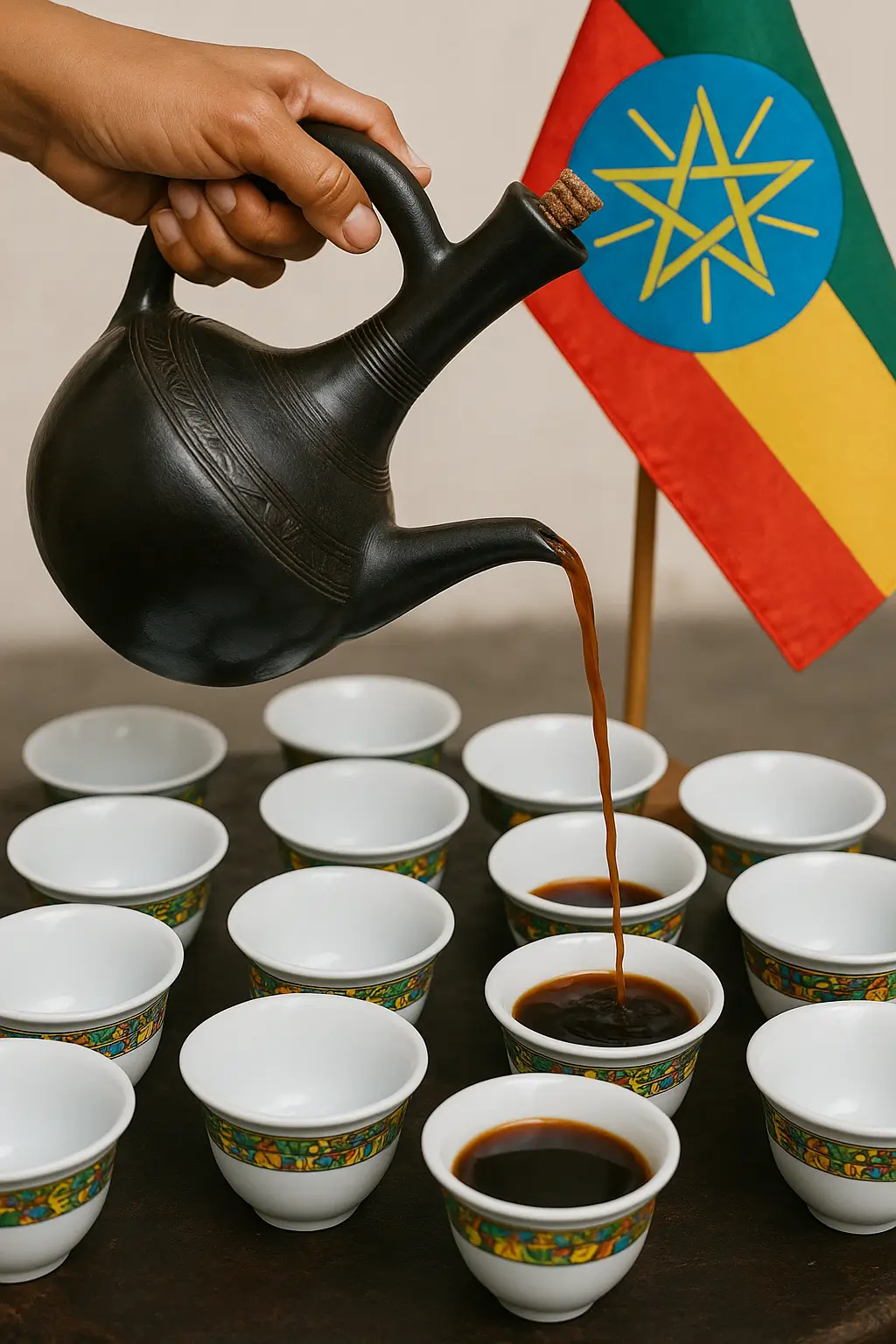Ethiopian coffee isn’t just a beverage. It’s a journey for your senses. This unique coffee stands out with its bright, fruity, and floral flavors. You’ll notice a lively acidity. It also has a smooth, often syrupy feel in your mouth. Why is it so special? Ethiopia’s ideal growing conditions make the difference. Think high altitudes, acidic soils, and varied climates.
- What is the history behind Ethiopian coffee?
- What are the primary Ethiopian coffee-growing regions?
- How do Ethiopian coffee processing methods impact the flavor?
- What is the cultural significance of Ethiopian coffee?
- What makes the Ethiopian coffee flavor profile so unique?
- Why is Ethiopian coffee a globally cherished beverage?
These conditions support a wide range of Coffea Arabica beans. Many grow wild and are cultivated naturally. Ethiopian Coffee is prized for its taste. It also holds deep cultural roots, tied to the country’s long history.
What is the history behind Ethiopian coffee?
The story of Ethiopian coffee begins in the 9th century. It comes from the legend of Kaldi, an Ethiopian goat herder. He saw his goats become energetic after eating red berries from a wild coffee shrub. Kaldi shared his discovery with local monks. They brewed a drink from the berries to stay awake during long prayers.
Ethiopia is the only place where Coffea Arabica grows wild. This makes it coffee’s botanical birthplace. People first harvested coffee from forests. Serious cultivation began around the 1500s. Commercial production grew further by the 1800s. Indigenous groups, like the Oromo people, helped shape early coffee culture. They saw coffee as a vital social and spiritual link.
This connection remained strong. It lasted through colonial influences and outside appropriation by Ottoman and European powers. Today, Ethiopia ranks as the world’s fifth-largest coffee producer. Its coffee industry supports many small farmers. It holds huge economic and cultural importance.
What are the primary Ethiopian coffee-growing regions?
Ethiopia’s main coffee regions each offer distinct coffee types and flavor profiles. This shows the country’s diverse local environment. High altitude, acidic soils, and varied climates shape the beans. Many heirloom coffee varieties thrive here. They often grow wild and are cultivated organically. This leads to an amazing range of tastes.
| Region | Key Characteristics | Processing Method | Flavor Notes |
|---|---|---|---|
| Sidamo | High altitude (1,500-2,200m), slow cherry maturation, complex flavors | Washed | Floral, citrus, lemon, lime, bergamot, sweet berry |
| Yirgacheffe | World-famous sub-region, light body, distinct profile | Washed (Wet) | Jasmine, citrus, peach, tropical fruits, berry, chocolate |
| Harrar | Eastern Ethiopia, wild native trees, heavy body | Natural (Dry) | Winey, fruity, blackberry, jammy, spicy, blueberry, banana, strawberry, mint |
| Limu | Southwestern Ethiopia, balanced body, medium bean size | Washed | Sweet, spicy, winey |
| Djimma | Southwestern Ethiopia, significant commercial producer | Varies (often natural) | Commonly commercial-grade, contributes to volume |
What coffee characteristics come from the Sidamo region?
Sidamo lies in southern Ethiopia. It produces complex coffees with bright acidity. Its beans often carry notes of:
- Floral
- Citrus
- Lemon
- Lime
- Bergamot
- Sweet berry undertones
The region’s high altitude, from 1,500 to 2,200 meters, allows coffee cherries to mature slowly. This intensifies the intricate flavors. Sidamo coffees usually have a medium to full body and low acidity. Key heirloom varieties here include Kurume, Welicho, and Dega. Producers in Sidamo often use the washed method. This boosts the coffee’s clean taste and brightness.
What makes Yirgacheffe Ethiopian coffee unique?
Yirgacheffe is a famous sub-region within Sidamo. It’s known for its distinct coffee profile. Coffees from Yirgacheffe feature:
- Light body
- Bright acidity
- Strong floral, tea-like aromas
The region mostly uses wet, or washed, processing. This creates a clean, crisp cup. Its unique flavor notes often include jasmine, citrus, peach, and various tropical fruits. Yirgacheffe also offers pleasant berry and chocolate hints. Coffee connoisseurs highly seek this variety.
What distinct flavors does Harrar Ethiopian coffee offer?
Harrar comes from eastern Ethiopia. It gives a unique, traditional coffee experience. These coffees are mostly dry processed. They come from wild native trees and have a heavy body. Harrar offers distinct winey and fruity flavors, including prominent blackberry and jammy tones.
You might also notice spicy undertones. Expect notes of blueberry, banana, strawberry, and even a hint of mint. Harrar coffee is often sorted into longberry, shortberry, or mocha (peaberry) types. People often value its intense fruitiness in high-quality espresso blends.
What are the characteristics of Limu and Djimma Ethiopian coffee?
Limu, located in southwestern Ethiopia, is a lesser-known but well-regarded coffee region. Limu coffees are typically washed processed. They grow at altitudes between 1,100 and 1,900 meters. These coffees have a balanced body with sweet, spicy, and winey flavors. This medium-bean-sized coffee has earned a reputation as one of Ethiopia’s best highland coffees.
Djimma, also in southwest Ethiopia, is a big commercial coffee producer. While Djimma coffees often lean towards commercial grade, they add to the overall range and volume of Ethiopian coffee exports.
How do Ethiopian coffee processing methods impact the flavor?
Ethiopian coffee producers mostly use two methods: washed (wet) processing and natural (dry) processing. Both deeply influence the final flavor. Each method pulls out different characteristics from the coffee cherry. This creates varied sensory experiences.
Washed processing starts with removing the coffee cherry’s outer skin and pulp. The beans then ferment in water. This breaks down the mucilage layer. After, workers thoroughly wash and sun-dry the beans. This method typically results in a clean, bright cup. You’ll find prominent floral and citrus notes. It also brings higher acidity and a lighter body.
Natural processing dries the entire coffee cherry under the sun for weeks. This lets the fruit and mucilage ferment slightly before hulling. This traditional approach is common for about 70% of Ethiopian coffee. It needs less labor and minimal water. Natural processed coffees usually have a fuller body. They taste sweeter, more fruit-forward, and wine-like. This method truly shows the fruit’s natural sweetness.
What is the cultural significance of Ethiopian coffee?
Coffee plays a central role in Ethiopian culture, especially through the Habesha coffee ceremony. This ritual is more than just drinking coffee. It’s a daily social gathering. It’s a ceremonial event that symbolizes hospitality, community bonds, respect, and cultural heritage. It’s a collective time for people to gather, share, and offer good wishes.
The woman of the household typically performs the ceremony. It’s a precise, intricate process. She:
- Roasts green coffee beans over an open flame.
- Grinds them with a traditional wooden mortar and pestle called a Mukecha.
- Brews the coffee in a special clay pot known as a Jebena.
Sharing the rich smell of freshly roasted beans with guests acts as a warm welcome. It starts the sensory experience. The ceremony setting itself is carefully prepared. People often spread fresh grass on the floor. They burn incense to purify the space. This practice holds historical meaning. It connects back to Kaldi’s legend. It affirms coffee’s role as a source of spiritual comfort. The coffee is served in multiple rounds. Each round has specific names and social meanings. This reinforces the deep tradition in this unique practice.
What makes the Ethiopian coffee flavor profile so unique?
Ethiopian coffee’s flavor profile is truly unique. It stands out with a lively mix of distinct notes and textures. Its main features include an amazing array of fruity and floral notes. These cover a broad range. You might taste bright citrus and delicate jasmine. You could also find sweet berry flavors, often described as blueberry or blackberry-like “jammy” tones.
Ethiopian coffees often show a wine-like complexity. You might find subtle hints of lemongrass or even chocolate in some varieties. The processing method heavily influences these flavors. Washed coffees often highlight floral and citrus. Natural processed beans emphasize intense fruity and jammy qualities.
A lively acidity is another hallmark of Ethiopian coffee. It makes for a wonderfully crisp, vibrant cup. This acidity can range from a pleasant tanginess to a more intensely bright, mouth-puckering feel. This adds layers of complexity. Additionally, Ethiopian coffees often have a smooth, syrupy mouthfeel. They offer a light to medium body that can be creamy or honey-like. This sets them apart from the often more wine-like feel of other African coffees.
Why is Ethiopian coffee a globally cherished beverage?
Ethiopian coffee is cherished worldwide. It’s the undeniable birthplace of coffee. It offers amazing diversity. The ideal growing conditions across its distinct regions combine with varied traditional processing methods. This creates an unmatched sensory experience. From Kaldi’s legendary discovery in the 9th century to the intricate Habesha coffee ceremony, coffee is part of Ethiopia’s identity.
Ethiopian coffee gives you an unparalleled journey of taste and culture. To truly appreciate this unique beverage, explore different Ethiopian varieties. Try a washed Yirgacheffe for its bright floral notes. Or savor a natural Harrar for its intense fruity and wine-like complexity. Seek out coffee roasted from Ethiopian beans. Or learn more about the traditional Ethiopian coffee ceremony. Each step will deepen your appreciation for this remarkable origin.









